The Different Types of Reptile Enclosures: Which is Right for Your Pet?
Reptiles are unique and fascinating pets, but they have specific needs when it comes to their living spaces. A suitable reptile enclosure is crucial for their health and well-being, providing them with a comfortable and secure environment. There are various types of reptile enclosures, including terrariums, vivariums, cages, paludariums, etc, each with its advantages and disadvantages. It’s important to consider the size, species, and behavior of your reptile when choosing the right type of enclosure so that you can create a safe and suitable habitat for your pet. This is a comprehensive guide about The Different Types of Reptile Enclosures: Which is Right for Your Pet? Continue reading to know more!
The Different Types of Reptile Enclosures: Which is Right for Your Pet?
It’s important to carefully consider the specific requirements of your pet, such as temperature, humidity, size, and species, when choosing a reptile enclosure, to ensure that you provide the best possible habitat for your pet. Here are the common types of reptile enclosures:
- Terrariums:
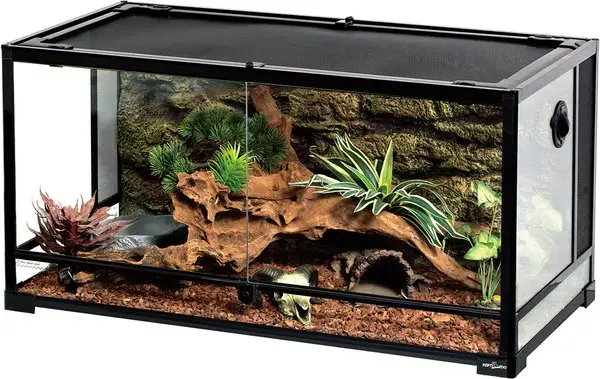
Image credit @ Chewy.com
A terrarium is nothing more than a container meant to house small animals or plants in a controlled setting. These are reptile-specific enclosures with a front opening. They are available in a variety of materials (mainly glass, PVC, or wood) and may be manufactured in almost any shape or size, with glass or acrylic swinging or sliding doors. You can house Chameleons, Geckos, Frogs, Salamanders, etc in a terrarium.
Pros | Cons |
They assist in the growth of plants that are difficult to grow in dry air. | Indoor plants can be destroyed by direct sunlight or exposure to excessive heat. |
They offer a confined area for a garden, a “mini-garden”. | Because there is no ventilation, sealed terrariums are more prone to mold. |
Artificial light, like fluorescent or LED, can be utilized very effectively. | It is quite difficult to get water out once it is inside. |
Terrariums do not require frequent watering. | These are expensive. |
The seal prevents the entry of pests. | – |
Maintain humidity and heat. | – |
Terrariums require less maintenance. | – |
- Vivariums:
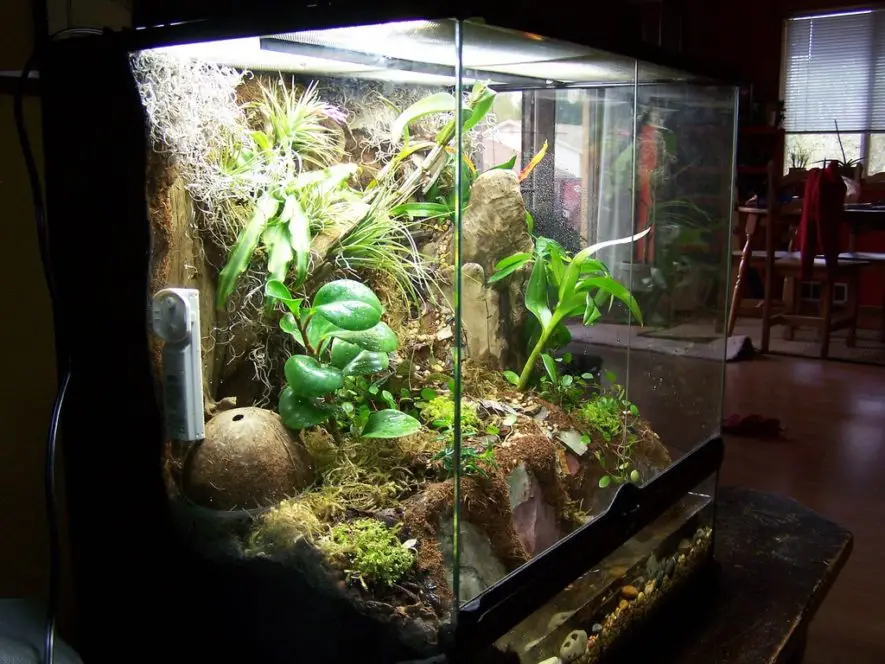
Image credit @ Terrarium Quest
A vivarium is an enclosure made to keep animals in semi-natural environments. Vivariums are excellent enclosures for mimicking natural settings on a small scale. These tanks are generally made of glass or clear plastic and are used for observation, research, or keeping pets. You can also keep Chameleons, Geckos, Frogs, Salamanders, etc in a vivarium.
Pros | Cons |
Vivariums can be found in a range of different materials, including mesh, glass, wood, and hood. | Cleaning of the animal cages |
Maintains a stable habitat for the species’ comfort and safety. | Plant care |
There are few decorations and plants. | Maintenance of pond levels and p.H.’s |
In comparison to terrariums, it is less expensive. | – |
Some cages contain lightning. | – |
A bit high and wide | – |
- Paludariums:
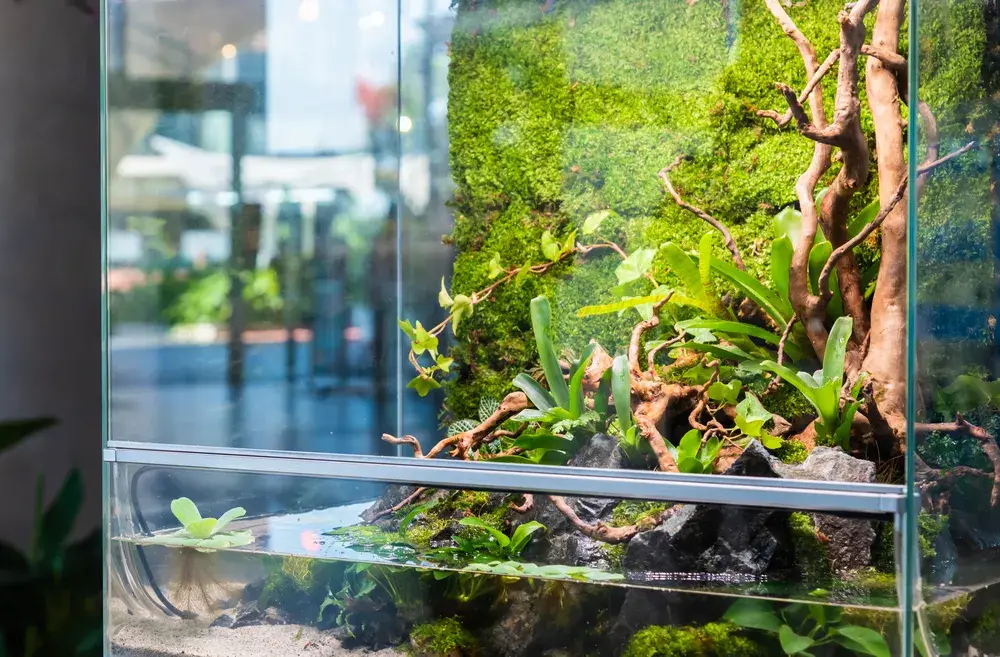
Image credit @ The Reptile Room
A paludarium is a hybrid of an aquarium and a terrarium. It is an artificial habitat that provides a semi-aquatic environment for animals that need both water and land. It often includes a pool of water, living plants, and substrate that may be utilized in or out of water. They may also contain land features like soil, rocks, and a multitude of land plants. You can house Turtles and Frogs in a paludarim.
- Aquariums:
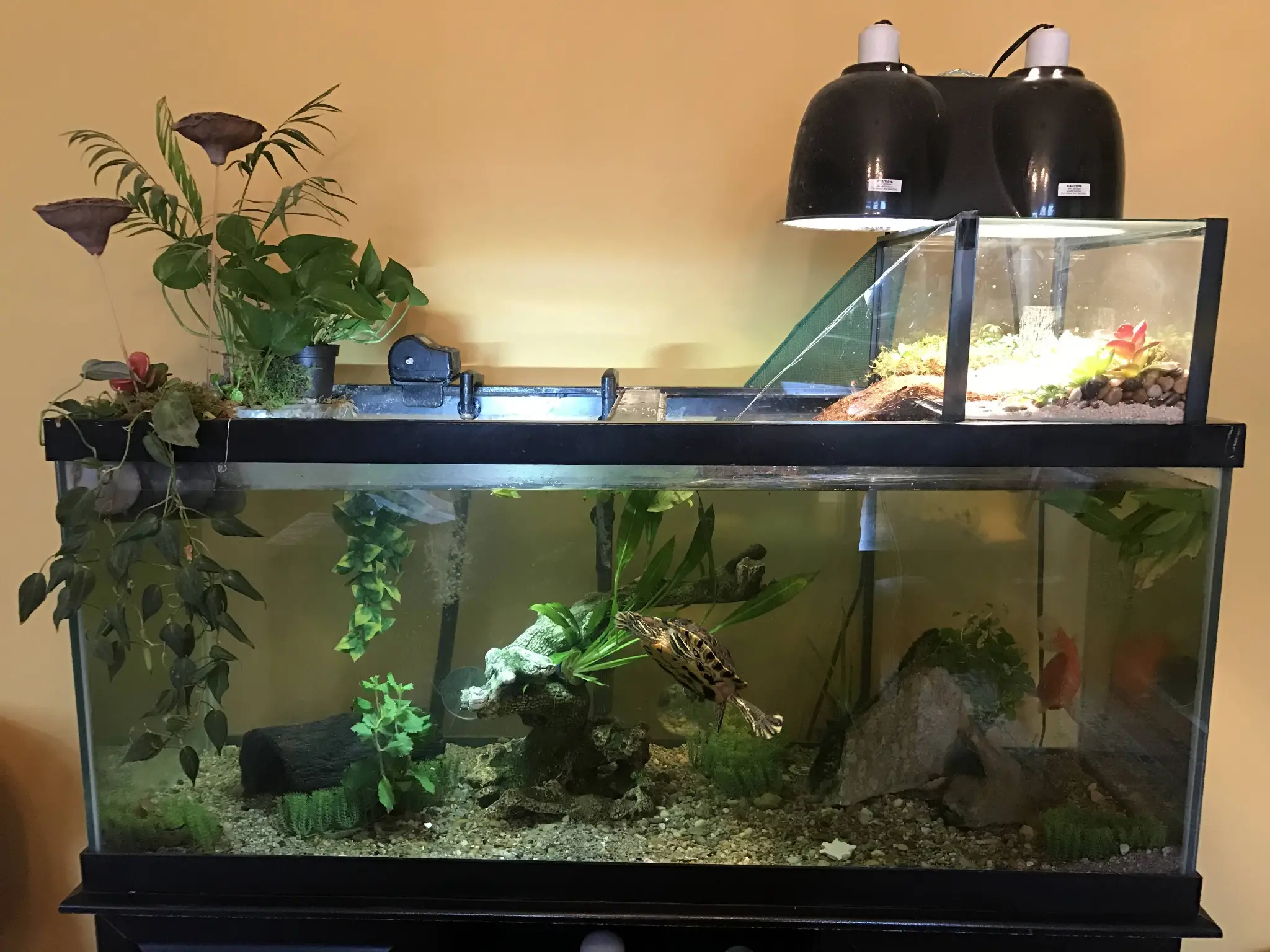
Image credit @ Pinterest
These are top-opening glass tanks that are most typically utilized to house fish, although they’re also employed to keep reptile pets that require a completely aquatic environment, such as turtles and some lizard species. Aquariums designed for reptiles typically include a screen top. Turtles, Water Dragons, and Amphibians can live in aquariums.
Pros | Cons |
Watertight | Heavy |
Many reptiles that can be kept in a single room | Doesn’t hold humidity or heat well without modification |
Easy to clean and maintain | Vulnerable to escapes |
Escape-resistant | Only accessible from the top, which may make people defensive |
Retains humidity well | Animal can be stressed out due to transparent walls |
Uses vertical space, limiting the setting’s footprint | If damaged, shatters into sharp shards |
Cost-efficient to heat | Only found about 75 gallons (48” x 18” x 21”) usually |
- Screen Cages:
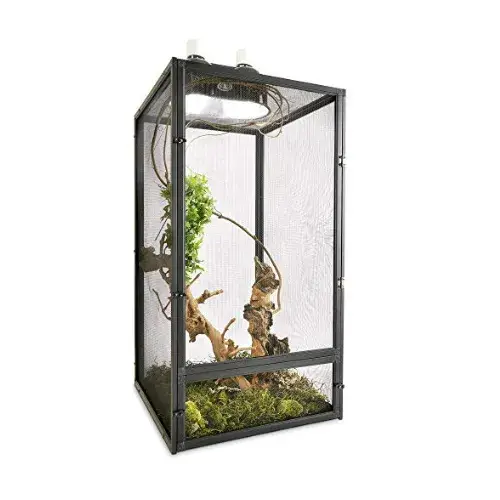
Image credit @ Reptile Cymru
Screen cages are simple, lightweight, and vertically stacked reptile containers with mesh walls that focus on height. This is an example of a cage made to fulfill the specific requirements of a certain species of reptile, like a chameleon. Chameleons require a lot of climbing space, cold air, a warm basking area, a lot of water, and adequate ventilation in their care. These are often made from aluminum window screening, rolled, or extruded aluminum. The majority is composed of the same screen panels that are used on home windows.
Pros | Cons |
Very well-ventilated | Leaky |
Facilitates overhead lighting and heating | Limited sizes are available commercially |
Easy access from the front | Difficulty retaining heat or humidity |
- Stackable Cages or Racks:
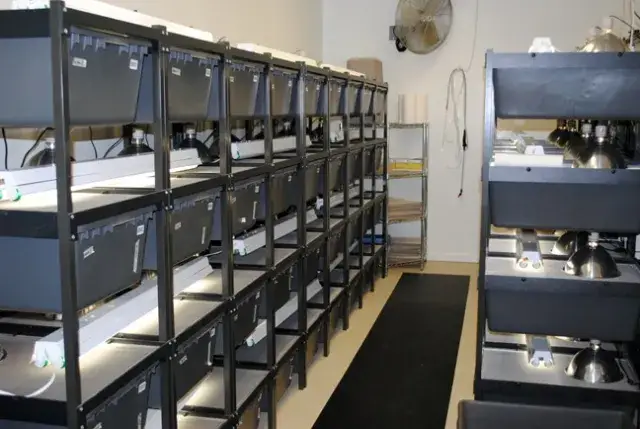
Image credit @ Reptiflies
Racks or Stackable cages are vertical shelf units intended to fit as many pets as possible into a compact area. They are usually outfitted with simple heating equipment like snug-fitting tubs, thermostats, and heat tape employed to make escape-proof cages.
Stackable cages are made for efficiency, thus a typical container in a rack system should be simple and fast to clean: a disposable substrate like a butcher paper, or paper towel, food, a plastic hiding box, and water bowls. For example, Small Lizards, Geckos, and Snakes can live in racks.
Pros | Cons |
makes use of vertical space to reduce the setting’s footprint | The size of the cage is restricted by the size of the available tubs – the maximum tub size is 175 quarts (44 gallons). |
Watertight | Restricted ventilation and space significantly limit temperature gradient |
Maximizes the number of reptiles that could be kept in a single room | may produce VOCs |
Retains humidity well | If the thermostat fails dozens of reptiles could die |
Escape-resistant | Limited ventilation |
Easy to clean and maintain | Space limitation restricts the possibility of creating a decorating environment. |
cost-efficient to heat | Not accommodate any type of supplementary lighting |
- Grow Tents:
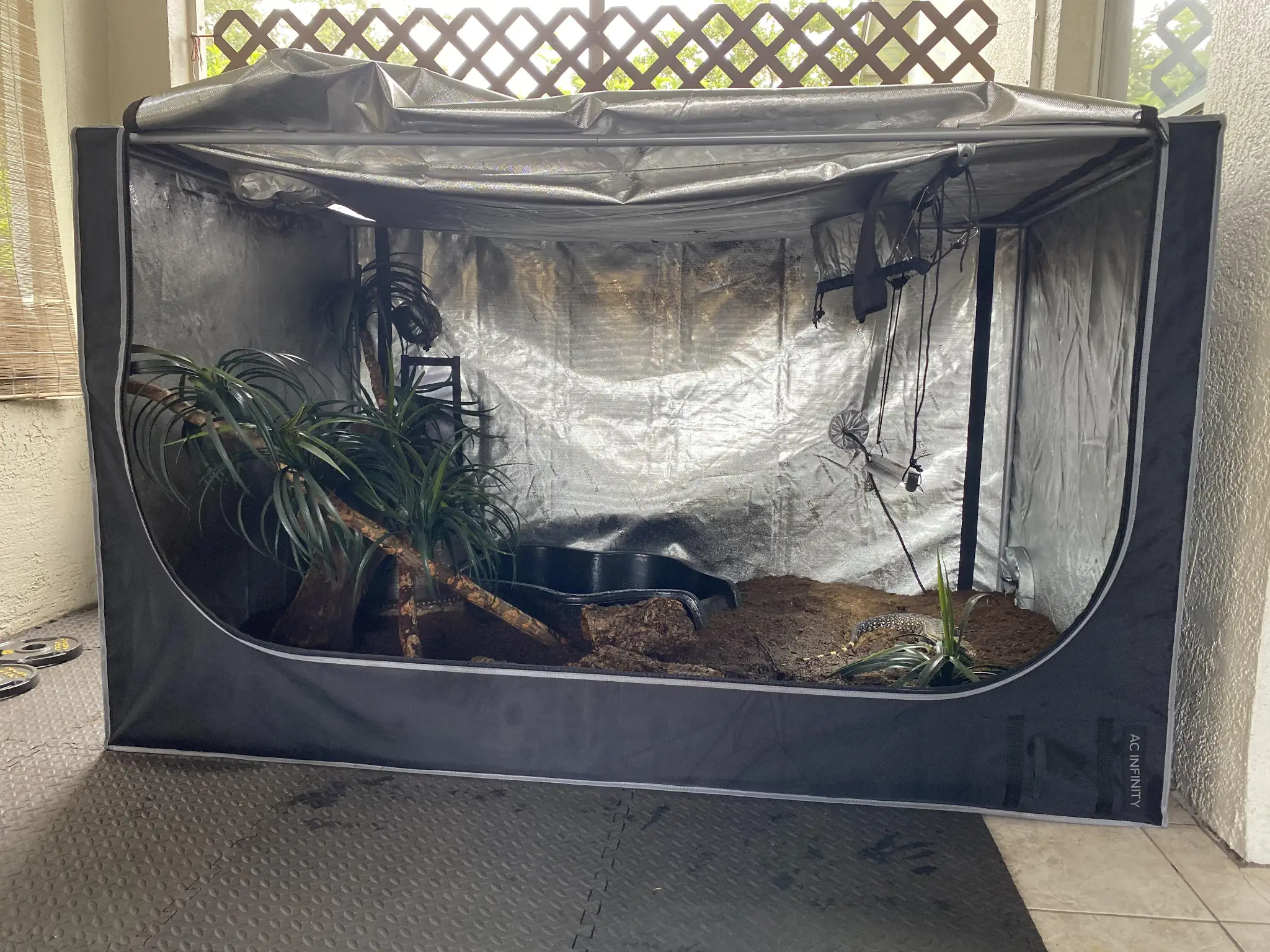
Image credit @ Reddit
Grow tents are utilized to grow plants more successfully inside and are well recognized for their application in indoor cannabis production. Several reptile enthusiasts, however, reuse them as reptile cages.
Pros | Cons |
Lightweight | Reflective inner lining might be bad for reptile eyes |
Cheap | Can be leaky |
Retains humidity and heat well | Limited ventilation |
Can be modified to adjust overhead heating and UVB | Prone to overheating |
Opaque walls | Not very durable and escape-proof |
– | Very Limited for viewing |
– | Unattractive |
- Tortoise Tables:
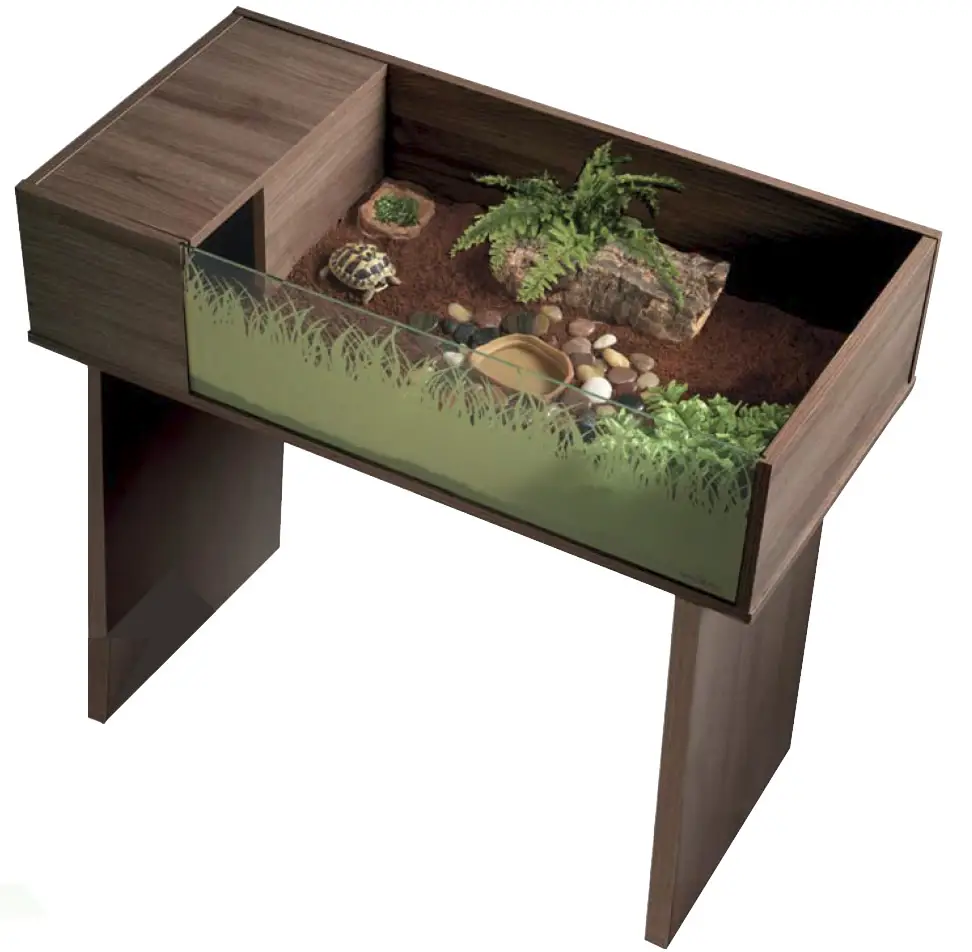
Image credit @ The Reptile Centre
The tortoise table is a type of cage (usually built of wood) that prioritizes floor space by having low walls, or no ceiling, and is often supported by legs that elevate it off the ground, similar to a dining table. This is designed to fulfill the special demands of a certain group of reptiles, like tortoises that have climbing skills and when confronted with transparent limits, they get agitated to the point of obsession.
Pros | Cons |
Lots of available floor space | Wood is flammable |
Opaque walls | The degree of attractiveness varies with the type and design of wood. |
Easy access | Can be difficult to disinfect |
High ventilation | Generally, not commercially available in the US |
Affordable | may start to rot if there is standing water or a lot of humidity |
Facilitates overhead lighting and heating | Do not retain humidity or heat well |
- Tubs:
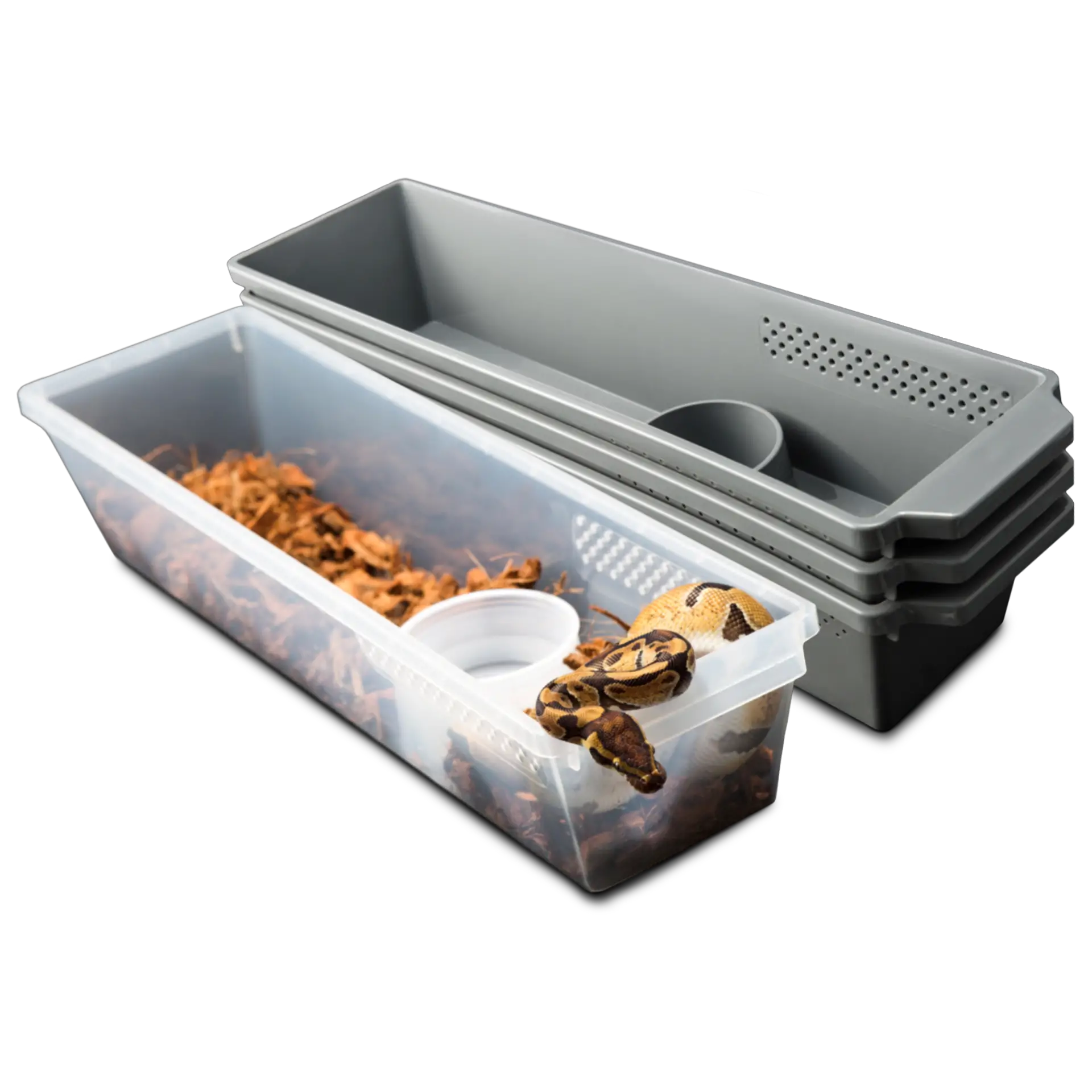
Image credit @ Freedom Breeder
Tubs are plastic storage containers that are reused into reptile habitats and in Europe called RUBs. These are most commonly seen in the above-mentioned rack arrangement, although they may also be found as standalone enclosures. Ventilation holes are frequently drilled into tubs and heated with a heat pad or mat.
Standalone tubs are less sanitary when not part of a rack system. They usually include a substrate, a conceal box, food or water bowls, and one or two decorations items like artificial foliage and low climbing branches. Because standalone tubs aren’t restricted by racks, they have a 65-gallon capacity or could be as large as 54″ L x 22″ W x 15″ H.
Pros | Cons |
Readily available | Only heating alternative (without modification) is a heat tape or heating pad |
Watertight | Can be challenging to create a diverse temperature gradient |
Lightweight | Ventilation is highly limited |
Holds humidity and heat well | The amount of accessible space is restricted by the size of tub that can be found |
Easy to clean and maintain | Not very attractive |
Cheap | Limited viewing |
Opaque or near-opaque walls | Setting up UVB lighting might be challenging or perhaps impossible depending on the occupant |
Fairly escape-proof | May produce VOCs |
- Furniture Conversions:
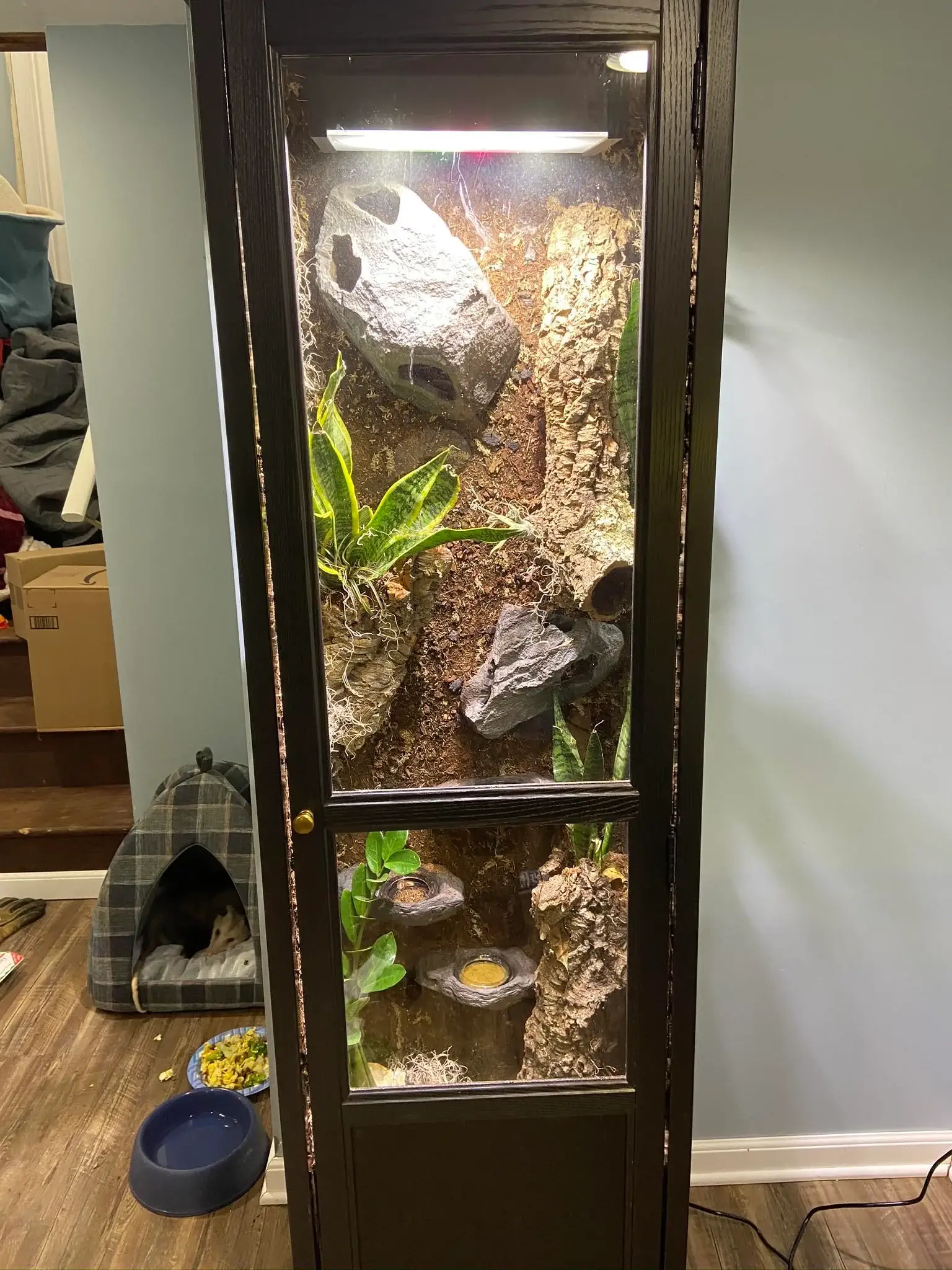
Image credit @ Reddit
Reptile cages designed from human furniture like bookshelves, coffee tables, and entertainment centers are known as furniture conversions.
Pros | Cons |
Customizable | Limited ventilation |
Attractive | Size is restricted by the furniture |
– | If not adequately sealed, will decay in the presence of moisture. |
– | Heavy |
– | Can be difficult to disinfect |
– | Access can be difficult |
Materials Used For Reptile Cages
As different materials have been utilized to manufacture reptile cages throughout the years, several trends have evolved within the industry. A number of these materials are popular due to their qualities and how they improve the housing and constant maintenance of pet reptiles. Unfortunately, certain materials are still utilized because they are inexpensive, ignoring the harmful effects on pet care.
Glass:
Glass is the traditional material for terrariums. Most pet stores carry glass containers in a range of sizes and designs. These enclosures are often less expensive than acrylic tanks. The cost of terrarium equipment and the animals that live in them will thus rise.
Most glass “tanks” are really fish tanks manufactured by huge commercial vendors for the major pet shop chains because they are inexpensive and sell well at consumer pricing points. The conventional sizes (10-gallon, 20-gallon, 40-gallon) are originated from the aquarium business and have been moved into the reptile market based on manufacturer convenience rather than what is optimal for reptile care.
Pros | Cons |
Hold humidity & water | Do not retain heat well |
Provide great visibility for owner | Top opening glass enclosures can be stressful for some reptiles |
Front opening options now more widely available | Usually only available in small sizes |
Low entry cost | Shatter on impact |
Available at almost any pet store | Visibility & reflection can stress animal out |
– | Difficult to modify & DIY with |
Wood:
Wood has always been one of the simplest and most adaptable materials to deal with. It is a fairly common material to use to make reptile cages because it is both forgiving and accessible. Wooden enclosures are widely accessible and come in a variety of sizes and designs. When it is used to construct large enclosures and habitats, wood is undoubtedly the most durable material. Particularly when a whole room modification is necessary.
If you are dealing with a reptile setting that doesn’t need a lot of moisture, wood is excellent. Sanitizing wood and ensuring that it lasts due to cleaning and exposure to the elements are the key challenges. Laminated wood is a fantastic alternative to ensure that there is a protective layer you can disinfect, but as quickly as the layer is damaged, there is an increased risk that you won’t observe any rotting that occurs beneath the laminate. When using melamine or other pressed woods, this is particularly true.
Pros | Cons |
Easy to modify | Flammable |
Potentially low entry cost | Not suitable for high moisture environment |
Strong & sturdy for large builds | Hard to sanitize |
Potentially low entry cost | Mold & rot possible, especially if outer lining is damaged |
Mesh Screen:
Mesh screen cages, which are quite popular for maintaining species such as chameleons, are affordable and widely available in most pet stores in the United States. Most homes do not provide a suitable long-term habitat for reptiles that require high humidity and ambient temperatures. The exception is for specific rooms with high temperatures and humidity.
Pros | Cons |
It’s inexpensive and simple to assemble. | The screen obstructs vision. Over time, certain screens will corrode. |
Allows for strong airflow. | Won’t hold humidity or heat. |
Plastic and Acrylic:
Reptile enclosures are made from a variety of plastics, such as ABS and acrylics. Acrylic is a superior thermal insulator than glass. This indicates that an acrylic tank will be less expensive to heat, which may be important for tropical species. Furthermore, various plastics are utilised for “tubs” for large-scale breeding, which is not appropriate for long-term care of pet reptiles. Plastic enclosures are still used in the pet reptile industry, although most manufacturers have switched on to alternative materials. The exception is ABS, which is frequently used for larger reptile enclosures.
Pros | Cons |
Very durable and simple to clean and maintain | Highly flammable (in most cases) |
Some polymers, such as ABS, can withstand significant effect and yet endure for a long time | High cost and transportation expense for huge one-piece units |
– | Acrylic scratches and discolours easily. |
– | Color options are limited. |
PVC:
Polyvinyl Chloride, perhaps one of the better materials for small to large reptile cages, is now the chosen option of many reptile enclosure producers.
The PVC trend is a natural progression as manufacturers seek for better materials that are both practical and functional. However, not all PVC is suitable for keeping pets, and PVC Trim board frequently available in larger hardware stores isn’t the same material utilized professionally, which can be hazardous to the inhabitants.
Pros | Cons |
Holds heat well | Scratches and dents easily |
Light weight | Some inexpensive imported PVC sheets include fillers or additives, which may cause the release of volatile organic compounds (VOCs) when heated. |
Can be heated and bent. | – |
Water resistant | – |
HDPE:
HDPE (High-density polyethylene) is a versatile thermoplastic with numerous advantageous qualities that is arguably the best material for reptile cages of any size. While HDPE costs nearly twice as much as PVC, it is widely utilised in a variety of applications such as water tanks, marine or boat construction, cutting boards for food preparation, food containers, outdoor and indoor playground systems, prosthetics and orthotics, and many more. We feel that HDPE is the greatest material for the building of reptile enclosures due to its vast range of practical, safe, and proven applications.
Pros | Cons |
Safe, scratch and impact-resistant, strong, environmentally stabilized, waterproof, recyclable, lightweight, odor, chemically resistant, and UV. Meets FDA & USDA standards in the food processing industry too. | Higher material costs |
Remember:
Any enclosure you purchase for a vivarium should keep in mind these six questions.
Is the enclosure safe and secure?
Ensure it is strong and well-built. There should be no sharp, rough, or protruding edges. Those inside may hurt the animal. Those outside may cause harm to you.
Is the enclosure escape proof?
It must have a secure top lid or another access door without any openings that animals may squeeze through. Small herps, including frogs, geckos, and serrated-tailed tree lizards (Holaspis spp.), have been lost as a result of the small areas that surround the screen top or door of many reptile tanks. Make sure the door or lid locks tightly so that strong animals like snakes cannot force them open.
Is the enclosure big enough?
Its dimensions and size have to be appropriate for your animal. You should never make an animal reside in an insufficiently sized enclosure. Tall enclosures are necessary for arboreal species. Pets who enjoy running around require a lot of floor space. Some animals require an enclosure that is both wide and long. They need a tank that is 5 feet long and 3 feet wide, for example, rather than one that is 5 feet long and 2 feet wide.
Can the enclosure sustain the necessary environmental conditions?
The majority of the vivarium should be manufactured of acrylic or glass if your animals and plants require high humidity. You require screened areas if they require excellent airflow. Occasionally, it might be challenging to maintain both fresh air circulation and a high humidity level. You might need to experiment by covering a portion of the screen until you get it perfect.
Will the enclosure meet aesthetic goals?
You probably are not too worried about appearance if you are buying it only for strictly utilitarian reasons. But if you want a display vivarium and it will be located in a public space, you have to ensure the enclosure and its accessories are appealing and it allows for easy viewing of the landscaping and animals.
Will the enclosure be able to house the necessary fixtures?
Although some enclosures include tops with light fixtures, your plants and animals may not need these. It is best to purchase an enclosure and a suitable light fixture separately if the provided bulbs cannot produce the sort of light your vivarium requires.
Conclusion:
In conclusion, there are many different types of reptile cages available, each with special characteristics and advantages. The ideal enclosure will be determined by the type of reptile you have, and also by its size, and requirements for temperature, and humidity. Glass aquariums, plastic cages, metal mesh cages, and wooden vivariums are a few popular choices. Whatever style you select, it’s essential to make sure the enclosure is well-ventilated, easy to clean, and provides enough room for your reptile to roam about and live peacefully. This detailed guide will be helpful for you about The Different Types of Reptile Enclosures: Which is Right for Your Pet?
FAQs:
How big should a snake enclosure be?
The growth of snakes is rapid. Choose a terrarium suitable for your snake’s species. Terrariums should be between ten and twenty gallons in size for small snakes, and between 30 to 55 gallons for larger snake species such as king snakes.
What kind of enclosure is best for a ball python?
The majority of adult ball pythons require terrariums with between three and six square feet of floor area and between twelve and eighteen inches in height. Young ball pythons, however, only need a small fraction of the area. A newborn to young snake requires a tank that is 20 gallons in size, while an adult snake requires a tank that is at least 40 gallons in size.
Are wood enclosures good for snakes?
Wood terrariums are excellent for keeping arboreal or terrestrial reptiles of any size, as long as the construction can support the enclosure’s size.
What is needed in a reptile enclosure?
Reptiles need a suitable habitat as well as sources of heat, light, and water while they are housed. Before getting your pet home, make sure the habitat is fully ready and secure.







